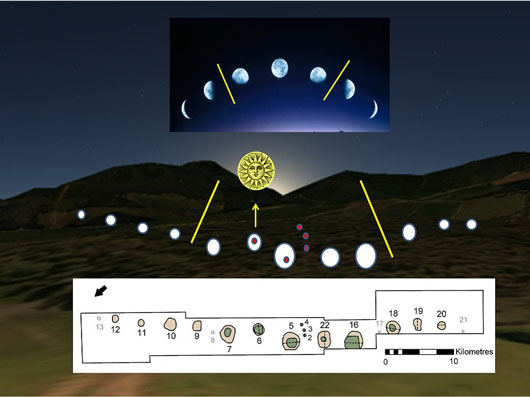World’s oldest calendar found in a Scottish field

The world’s oldest calendar has been found in a field in Scotland, and could date back to 8,000 BC.
Researchers at the University of St Andrews were part of the team which analysed the Mesolithic monument originally excavated in Aberdeenshire by the National Trust for Scotland in 2004.
Their research is now published in the journal Internet Archaeology and sheds new light on the luni-solar device.
The team, led by Birmingham University, believes the “calendar” was created by hunter-gatherer societies and pre-dates the first formal time-measuring devices known to humanity, found in the Near East, by nearly 5,000 years.
The capacity to measure time is among the most important of human achievements and the issue of when time was ‘created’ by humankind is critical in understanding how society has developed.
Until now the first formal calendars appear to have been created in Mesopotamia around 5000 years ago. But during this project the researchers discovered that a monument created in Aberdeenshire nearly 10,000 years ago appears to mimic the phases of the Moon in order to track lunar months over the course of a year.
The site, at Warren Field, Crathes, also aligns on the Midwinter Sunrise, providing an annual astronomic correction in order to maintain the link between the passage of time, indicated by the moon, the asynchronous solar year and the associated seasons.
Dr Richard Bates, Senior Lecturer in the School of Geography and Geosciences at the University of St Andrews, said: “St Andrews has an established reputation for remote sensing studies of early prehistoric sites in Scotland but the site at Warren Field is unique.
“It provides exciting new evidence for the earlier Mesolithic in Scotland, demonstrating the sophistication of these early societies and revealing that 10,000 years ago hunter-gatherers constructed monuments that helped them track time.
“This is the earliest example of such a structure and there is no known comparable site in Britain or Europe for several thousands of years after the monument at Warren Field was constructed.”
Project leader Vince Gaffney, Professor of Landscape Archaeology at the University of Birmingham, added: ‘The evidence suggests that hunter-gatherer societies in Scotland had both the need and sophistication to track time across the years, to correct for seasonal drift of the lunar year and that this occurred nearly 5,000 years before the first formal calendars known in the Near East.
“In doing so, this illustrates one important step towards the formal construction of time and therefore history itself.”
The Warren Field site was first discovered as unusual crop marks spotted from the air by the Royal Commission on the Ancient and Historical Monuments of Scotland (RCAHMS).
Dave Cowley, Aerial Survey projects manager at RCAHMS, said: “We have been taking photographs of the Scottish landscape for nearly 40 years, recording thousands of archaeological sites that would never have been detected from the ground.
“Warren Field stands out as something special, however. It is remarkable to think that our aerial survey may have helped to find the place where time itself was invented.”
Professor Clive Ruggles, Emeritus Professor of Archaeoastronomy at the University of Leicester, who advised the team, said: “The site did not mark particular moonrises as the changing patterns of moonrise are far too complex – the argument is that it represents a combination of several different cycles which can be used to track time symbolically and practically.
“There are certainly hunter-gatherer societies who use the phase cycles of the moon to help synchronise different seasonal activities but it is remarkable that this could have been monumentalised at such an early period.”
From 2004-6 the National Trust for Scotland excavated the Warren Field pit alignment, which lies on its Crathes Castle Estate, in collaboration with Murray Archaeological Services. The Trust’s Archaeologist for Eastern Scotland, Dr Shannon Fraser, said: “This is a remarkable monument, which is so far unique in Britain. Our excavations revealed a fascinating glimpse into the cultural lives of people some 10,000 years ago – and now this latest discovery further enriches our understanding of their relationship with time and the heavens”.
Dr Christopher Gaffney, of the University of Bradford, added: “For pre-historic hunter-gatherer communities, knowing what food resources were available at different times of the year was crucial to survival.
“These communities relied on hunting migrating animals and the consequences of missing these events were potential starvation. They needed to carefully note the seasons to be prepared for when that food resource passed through, so from this perspective, our interpretation of this site as a seasonal calendar makes sense.”
Note to Editors
* Time and a Place: A luni-solar ‘time reckoner’ from 8th millennium BC Scotland
Internet Archaeology, 15 July 2013 (http://dx.doi.org/10.11141/ia.34.1)
Issued by the Press Office, University of St Andrews
Contact Fiona MacLeod on 01334 462108/ 0771 414 0559.
Ref: (calendar 16/07/13)
View the University’s latest news at www.st-andrews.ac.uk/news
Category Public interest stories